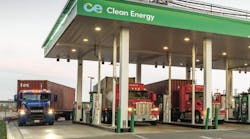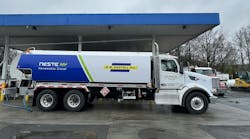When a fleet operation contemplates using natural gas to fuel its trucks, there are many costs involved. First, there’s the hefty extra investment for trucks designed to operate on either compressed natural gas (CNG) or liquefied natural gas (LNG). According to Toronto, Canada-based global transportation consulting firm Frost & Sullivan, medium-duty, spark-ignited CNG and LNG trucks can cost an additional $29,750 and $27,750, respectively, while the pricier “compression ignition” system used for LNG-powered, heavy-duty Class 8 models can cost $72,450 or more on average than a comparable diesel-powered unit.
Yet there are more subtle costs fleets must account for when examining a changeover to natural gas, e.g., training expenses for maintenance technicians and the investments necessary to make shops “compliant” to handle natural gas vehicles.
New vs. old
Indeed, any operation seeking to keep natural gas-fired trucks up and running needs to account for these critical maintenance factors. For starters, preparing a shop to handle natural gas-powered vehicles isn’t necessarily expensive; however, the cost is dependent on whether the shop is built new or gets retrofitted. That’s a lesson JX Enterprises, a chain of heavy-truck dealerships headquartered in Waukesha, WI, took to heart as it began building its 28,000-sq.-ft. JX Truck Center facility in Kronenwetter, WI, this year.
“We’d been planning on a new building for 10 years but really focused strongly on it for the last three or four,” says Sam Stevenson, the facility’s general manager. “But we’d just finalized the plans when we started talking about the growing demand for LNG- and CNG-powered trucks. That’s when we revisited the plans with our contractor to see what we needed to do in order to work on such equipment.”
Founded in 1970, JX Enterprises operates 15 medium- and heavy-duty truck dealerships operating as JX Truck Center and JX Peterbilt in Illinois, Indiana, Michigan and Wisconsin. It contacted a variety of dealerships and other maintenance shops equipped to work on natural gas-powered vehicles to get an idea of what a shop upgrade would cost.
Safety first
Stevenson says JX discerned that to retrofit several bays typically required, on average, a six-figure investment. For a brand new facility like the company’s dealership in Kronenwetter, however, only $30,000 would be required—largely because many of the more costly elements needed in a retrofit were either already in place within the new plans or easily added.
For one thing, JX had already planned to build a thickened firewall to divide the main eight-bay maintenance area from the six bays dedicated to the body shop.
The firewall allowed JX to work on natural gas trucks in the body shop, as it would provide a thick enough barrier to stop the escape of any gas into the main shop. Stevenson adds that an in-floor heating system powered by waste oil removed open flame issues, so any natural gas escaping from the vehicles could not be ignited.
The biggest addition to JX’s plans centered around a vastly beefed up exhaust fan system capable of venting 10,000 cu. ft. of air per minute versus the typical 2,000 cu. ft. capacity used in most shops. That has been integrated with a natural gas detection system.
“It cost us far less to integrate both of those technologies from the start rather than retrofit them into an existing shop,” Stevenson explains.
Detection and rapid venting systems are required for compliance with existing fire codes, explains Roy Svehla, senior manager of fleet maintenance for Republic Services.
Republic operates over 800 CNG- and LNG-powered refuse trucks in its total fleet of 15,000 vehicles and has plans to purchase another 550 by year’s end. As a result, the waste company is upgrading shops where those vehicles are operating with methane detection and air handling systems required by National Fire Protection Assn. (NFPA) Code 52, he says.
“Exhaust fans must provide improved ventilation as measured in air changes per hour,” Svehla points out, “and we tend to interlock the [natural] gas detection system to both the garage doors and the fans so that they will automatically open and operate if leaks are detected.”
Fire prevention
Scott Perry, vice president of supply management for Ryder Fleet Management Solutions, says that the NFPA codes that apply to maintenance shops working on natural gas vehicles—the above-mentioned Code 52 as well as Code 30—are not only federal-level guidelines applying to shops across the U.S., but also leave room for state governments and municipalities to add more stringent standards.
Ryder learned that the hard way as part of a $38.7 million project launched with the San Bernardino Associated Governments in 2011 to deploy 202 heavy-duty natural gas vehicles as part of a truck rental and leasing program in Southern California.
Perry explains that the project required Ryder to upgrade three existing maintenance facilities in California— Rancho Dominguez, Orange, and Fontana—for indoor servicing of natural gas vehicles. The company is also in the midst of converting two outdoor bays at its maintenance facility in Tucson, AZ.
“The physical infrastructure cost of those upgrades was quite significant,” Perry notes, although Ryder declined to cite a specific dollar figure. “For a shop with one [maintenance] bay, the cost of installing methane detection systems and an air handling unit [to quickly vent any natural gas out of the shop] would not be as much. However, most of our facilities contain multiple bays so that expense was higher.”
Kelly Mills, western U.S. territory sales manager for Canada-based natural gas engine maker Westport Innovations, stresses that natural gas only ignites when two conditions are present: when the gas-to-air ratio is between 5 and 15% and is exposed to heat sources in excess of 1,200 deg. F.
Providing heat
As a result, he says, the heat generated by cigarettes and cigarette lighters is not sufficient to ignite natural gas that’s within the proper gas-to-air concentration band, but the heat generated by a welder’s torch is. That’s why certain job functions needed to be relocated within the shop as part of the NFPA certification process, says Ryder’s Perry.
Based on what Ryder has learned to date, upgrading one of its average- sized shops to meet natural gas requirements should now take anywhere from 60 to 90 days.
Republic’s Svehla points out that while retrofits for some of his company’s shops can cost more than others, replacing the heating system is generally the main expense.
From a timing perspective, Svehla adds that all of Republic’s shop overhauls were done in parallel with the construction and permitting of the natural gas filling station built to serve each location. Svehla also notes that technician training costs are lower than expected, thanks partly to training resources provided by truck and natural gas engine makers alike.
Westport’s Mills, for example, explains that his company offers customers access to a four-day training package, much of which can be conducted online through webinars.
The final area that Ryder dealt with was the upgrade, and in some cases completely changing, of the parts inventory at each of its facilities tagged to handle natural gas-powered trucks. “These vehicles require new and different parts, from injectors to fuel hoses, so we needed to add those to inventory shelves,” Perry says.
“It’s just one of those things you must consider when you are doing your homework prior to a shop upgrade,” he stresses. “That’s probably the most important lesson we learned: Do your homework. There’s really no one standard set of blueprints for shop upgrades like this; no simple implementation process.”


